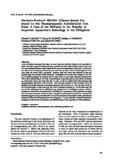Hatchery-produced milkfish (Chanos chanos) fry should be fed docosahexaenoic acid-enriched live food: A case of the difficulty in the transfer of improved aquaculture technology in the Philippines
Share
Abstract
Levels of highly-unsaturated fatty acids, the most important nutritional factors in fry production of marine fish, were compared between hatchery-produced and wild-caught milkfish Chanos chanos fry. The most striking difference found between the fry was in docosahexaenoic acid (DHA: 22:6n-3) levels: DHA levels in hatchery-produced fry were only 37% and 18% of those in wild-caught fry in the polar lipids and neutral lipids, respectively. However, high DHA levels were detected in ovary and spawned eggs from hatchery-reared broodstock. Investigation on the time course change in DHA levels of hatchery-produced fry revealed that the DHA levels of polar lipids drastically declined from 25% at day 0 posthatching to 5% at day 14 posthatching. Nannochloropsis sp. and rotifers Brachionus sp., which were used as live food from day 2 to day 14, did not contain DHA with relatively high eicosapentaenoic acid (EPA: 20:5n-3) levels. DHA level was restored to 13% in 45-day old fry by feeding of formulated diets with a substantial amount of DHA from day 15. Thus, the lack of DHA in the live food appears to lead to the low DHA level in hatchery-produced fry. On the other hand, the cost of DHA enrichment for one milkfish fry was estimated to be 2.6 Philippines centavos, which is equivalent to about 10% of the market price of milkfish fry. The increase of the production cost might not be accepted in domestic hatcheries under competitive marketing with imported fry. Financial and marketing support by the government will be one of the measures to encourage the stable production of domestic milkfish fry with high quality in the Philippines. It is also necessary to conduct institutional campaigns to inform local fry producers and milkfish farmers of the importance of DHA-enrichment.
Suggested Citation
Ogata, H. Y., Chavez, D. R., Garibay, E. S., Furuita, H., & Suloma, A. (2006). Hatchery-produced milkfish (Chanos chanos) fry should be fed docosahexaenoic acid-enriched live food: A case of the difficulty in the transfer of improved aquaculture technology in the Philippines. Japan Agricultural Research Quarterly , 40(4), 393-402. http://hdl.handle.net/10862/2049
Subject
Collections
- AQD Journal Articles [1215]


